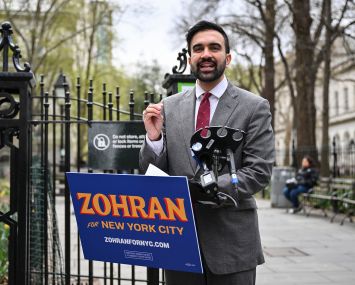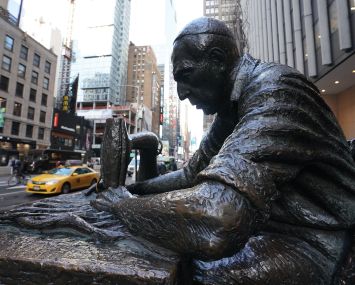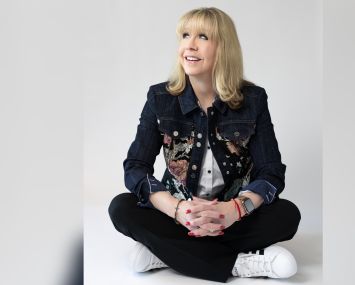Douglas Durst Opens Up on Life, Business, Tax Incentives and Family
By Terence Cullen July 20, 2016 10:30 am
reprints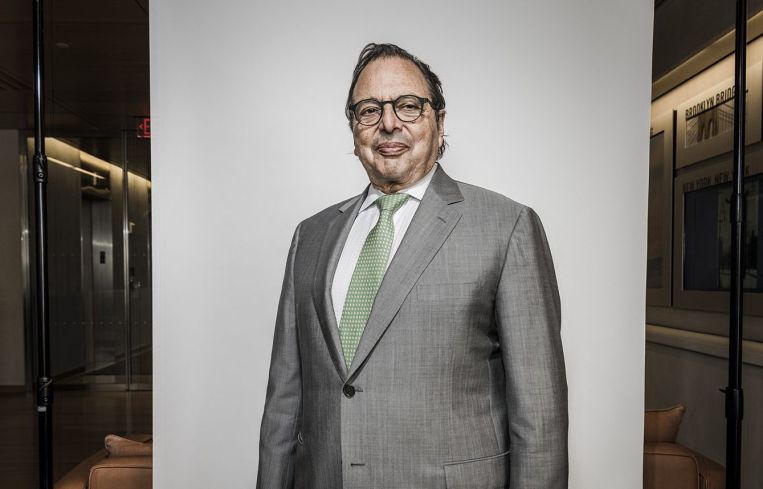
From his company’s offices on the 49th floor of One Bryant Park, Douglas Durst has a pretty solid view of the real estate empire he and his family’s Durst Organization have built.
Of course, there’s One Bryant Park itself, which opened in 2009, as well as 4 Times Square next door. Looking south from the building, 3-million-square-foot 1 World Trade Center that Durst owns with the Port Authority of New York & New Jersey, is in clear sight. The 71-year-old chairman of the company originally opposed the tower’s timing before signing an agreement to become the managing partner in 2013.
To the west is VIA 57 West, a tetrahedron-shaped residential building with an official address of 625 West 57th Street between 11th and 12th Avenues. The property was starchitect Bjarke Ingels’ first project in the United States and features 45,000 square feet of retail, the bulk of which has been signed to Livanos Restaurant Group, the American Kennel Club and the Mark Cuban-owned luxury cinema Landmark Theatres.
Traditionally a commercial landlord that developed along Avenue of the Americas and Third Avenue, the company has increasingly focused on residential projects in recent years. At 100 West 31st Street between Avenue of the Americas and Seventh Avenue, it is developing EO¯S, a mixed-use property named for the Greek goddess of the dawn with 375 rental units and 200,000 square feet of commercial space. Nike last year signed a 147,000-square-foot lease to move its New York City offices to the building. In Astoria, Queens, Durst is also developing Hallets Point, a multiphase project along the East River that broke ground on its first phase earlier this year. Because the 421a tax abatement has expired, the company has publicly stated it financially cannot move forward with later components of the project.
Durst, a resident of Westchester who last month celebrated his 50th anniversary at the company, discussed these projects with Commercial Observer last week. He sported a gray suit with a green tie and round glasses with an accent of matching green along the top of the rims. He also wore a Fitbit with a purple wristband band and octagon-shaped cufflinks with an etching of 1 WTC at the center. (He started a tradition more than 15 years ago to have cufflinks made for his employees to commemorate a building’s completion.)
About a year ago, Durst also elected to have a portion of his right leg removed following decades of pain from an accident 44 years ago when he and his family lived in Newfoundland, Canada. He has been adjusting well, he said. Durst also reflected on his uncle, David Durst, who led the company’s construction operations and died in May of natural causes at the age of 90—thus ending the second generation of the real estate dynasty—as well as his brother, Robert, whose alleged tale of murder (and general weirdness) were chronicled in “The Jinx,” a six-episode HBO series that premiered last year. (Douglas sued director Andrew Jarecki over how he obtained video testimony but dropped the case in April 2015 when it was revealed that Robert provided it to the director.) Robert was convicted of a weapons charge in New Orleans and is awaiting extradition to Los Angeles to face murder charges. Durst said he expects to have to testify in the case in September.
Commercial Observer: Can we start off with what we can expect from VIA 57 West as a whole and the neighborhood emerging around it?
Durst: We’re very excited about the building, and the [activity] has exceeded our expectations in terms of velocity and the rents. We always were thrilled with the building but even more so now.
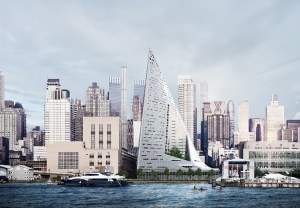
What were you looking for in terms of filling the retail there?
That was always a big question mark for us as to what we would be able to get [in terms of tenants because its location is so far west]. With the theater and the restaurant and the American Kennel Club, it’s just great. We still have a little bit of space left, which we think we’ll get somebody good for.
Who would you like to see there?
As you said, it’s an emerging neighborhood. There are not a lot of services for the tenants. So we’re hoping to find things that will be very good for the tenants.
How has the Bjarke Ingels design been received?
It is Bjarke’s first project [in the United States], and the accolades have been terrific. It was a little difficult to get built. But, everybody worked hard, and we got it done.
Do you take a little bit of credit for how much of a superstar he’s become in New York?
I take full credit for everything Bjarke has done [Laughs]. No, I’m very thrilled. It was a pleasure to work with him, and we still do a couple of things together.
Can you run us through some of the planning that went into EO¯S, too?
When the city created the zoning for that Midtown South area, they were trying to preserve the garment industry. You need to have about a third of the building be commercial. Besides us, most of the space was built as hotels. We tried to figure out how to make a hotel work. We just could not make it make sense for us. We made the decision to do commercial. A lot of people said the neighborhood is never going to be there for office space. But obviously we made a great deal with Nike, and they’re very excited about the space.
So it’s still a clothing company but with offices instead of manufacturing. I guess that’s a good definition of the new Garment District.
Right. I hadn’t thought about it, but yes.
And there’s a big sustainability factor as well?
Everything we do is built with sustainability in mind. We were trying to create our own guidelines, or we did create our own guidelines for the building. Both that and for VIA. All the material that goes into it has recycled content, no harmful materials in the construction. We recycle the construction waste. We’re very mindful of how we build the buildings.
Can you discuss why you’ve pivoted over the last few years to residential development instead of commercial?
With the amount of office space being built with public subsidies Downtown, which obviously we’re involved in, and in Hudson Yards [on the Far West Side], we think it’s going to be a long time before we’re in a position to build office space. I applaud those who are doing it, but we just think there’s a known demand for residential, and that’s what we’re focused on.
There’s usually an affordability component attached to the buildings you’re doing, right?
With most rental housing, you need the tax offset that you get by building affordable housing; 421a was developed not as a program for building affordable housing but as a program to offset the high taxes that rental housing pays here in the city. The tax percentage here in New York City is three times any other city [for rental]. That’s why you need to have the 421a program because you cannot afford to pay. It’s almost a third of your gross income, and it’s just not sustainable.
Since components of Hallets Point are delayed because the 421a program expired, are there any ways of doing those later phases without the tax abatement?
No.
Do you think the new office product Downtown and at Hudson Yards is going to have an impact on your holdings in Midtown either in near Bryant Park or on Third Avenue?
Well, it’s already having an impact on Sixth Avenue. I don’t think it will have an impact on Third Avenue because the people who want to be on Third Avenue do not want to be at Hudson Yards, and very few of them want to be Downtown. On Sixth Avenue, we lost Skadden, [Arps, Slate, Meagher & Flom at 4 Times Square] to Brookfield [Property Partners at 1 Manhattan West], which is part of Hudson Yards. We’re seeing stiff competition from Hudson Yards.
When we spoke earlier this year for the Power 100, you said hopefully you’d see a deal soon for the old Condé Nast space at 4 Times Square.
Still nearing something soon. I keep hoping we can announce it.
Any description of who might be taking that space?
We’re talking to service firms and some banks, basically.
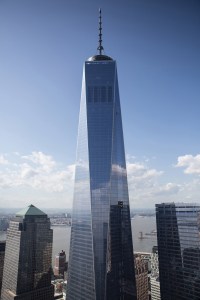
The pre-built and built-to-suit program at 1 WTC was recently expanded for a total of nine floors. Can you discuss the impacts that program has had on the building?
That’s about 10 percent of our building. It’s been terrific because tenants expand almost immediately after we move them in. With the pre-builts, it’s a very easy move for them. We’re very happy with our partner, the Port Authority, that they understand the need to keep this program going.
Do you see more media companies coming into the building, too?
We’re seeing a lot of interest from the media companies and from the internet companies. It’s smaller space. We have a new build-out for them with exposed ceilings to make it look more like Midtown buildings.
What has it been like to work on 1 WTC?
In the beginning, it was very difficult to convince the Port that we knew what we were doing, because they thought that it was their building. We convinced them that we’ve had experience in office buildings. It’s a lot better now; they have a much better understanding of our role. But it was a struggle to work and get them to understand that we’re not a contractor, we don’t work for them, and that we are a partner. They’re supposed to take our advice.
You originally opposed its construction.
I opposed the timing of the building. I opposed having all the buildings getting finished at once. It’s the crown jewel, and that should come after everything is finished, and it’s the most valuable of the buildings. My father opposed [construction of] the original World Trade Center.
What would he think to know that his company is now the builder and the manager of it?
I think he would be very proud.
Can you reflect on your uncle David’s passing and that second generation of the organization?
He was part of my life for many years working here. I never intended to go into the real estate business. He always took a paternal interest in me. Not that my father didn’t, but my father was a more distant person than David. I miss [David] sorely.
What did he teach you?
He was an engineer involved in the construction. I had very little knowledge about that. So he was very helpful in making sure I used the correct phrases and understood the process and was a mentor to me on the construction side.
What kind of career did you want?
When I went to college, my intention was to go into diplomatic service. I studied economics and the economics of developing countries. I went to New York University’s urban studies program. But I began working here part time. Then I met my wife, and we had kids. I started working full time. I’ve been here ever since. I just had my 50th anniversary with the business.
You lived up north for a little while, too, right?
In Newfoundland in the 1970s when times were not good for real estate. I took some time off with my wife. We had just finished developing a building at 170 West 78th Street with Eli Zabar [owner of Zabar’s], which had been a complete disaster.
Why is that?
The timing was absolutely terrible. We were trying to sell apartments when there was no market for apartments. I couldn’t even sell one to my sister. Then we decided to go away, up to Newfoundland, and that’s where I had my accident. [A cast-iron stove burst in their home, and a piece of it ripped into his calf.] I was a hippie and wanted to get away from it all. I ended up having to be evacuated by first a jet plane and then a helicopter to the hospital. So I decided I should stay in New York—it’s a lot safer here.
It’s about a year since you had your surgery, correct?
Yes, July 27.
How are you getting used to it?
It was a little slower to get here [to the office]. But I’ve been playing tennis and getting much more mobile. I’m always pleased that I did it, because I was feeling terrible before so it was a good thing. I expect to be more mobile than I was.
Would you ever consider getting away from it all again and becoming a hippie?
No. I did that. We have five grandkids, and they’re a big part of our lives.
What are your thoughts on “The Jinx?”
It’s a relief that my brother is in jail and will be there for a while.
